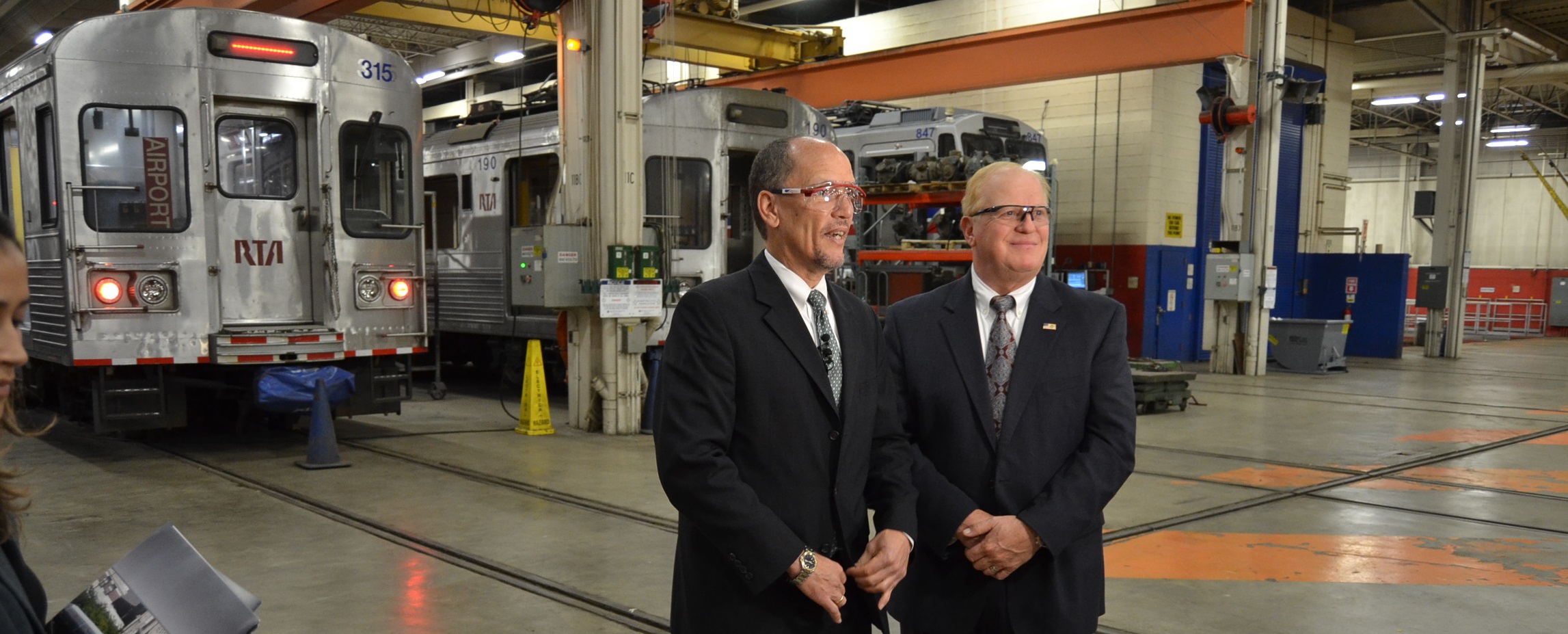Nov 2, 2015
CLEVELAND – “In a year where collaboration is taking center stage, it is great to see the collaborative efforts of the two federal agencies, labor unions and some of the finest educational institutions in the country produce successes like we are seeing in Cleveland,” said Valarie J. McCall, Chair of the American Public Transportation Association (APTA).
That success is translating into jobs, and US Department of Labor (DOL) Secretary Tom Perez came to Cleveland today to take note.
Like transit agencies across the country, the Greater Cleveland Regional Transit Authority (RTA) is facing a wave of retirements among skilled workers in front-line positions -- bus and rail mechanics, signal technicians and bus operators.
That’s why RTA is leading the charge, to kick off a standards-based training and apprenticeship program funded by a $400,000 DOL grant. RTA’s partners include Cuyahoga Community College, Cleveland State University and El Barrio.
“These top-notch institutions are working together like never before and leading the way in an effort that moves both the country and the economy forward,” said McCall.
McCall joined Secretary Perez, RTA CEO and General Manager Joe Calabrese, members of the Amalgamated Transit Union (ATU), Carolyn Flowers of the Federal Transit Administration (FTA), the Transportation Learning Center (TLC) and education officials for a roundtable discussion about the new front-line apprenticeships that RTA is implementing for bus and rail vehicle maintenance technicians and signal technicians.
“These collaborative efforts help improve the readiness of potential future employees to enter these technical apprenticeships and careers,” said McCall, who is also an RTA Board member.
“And they help expand employment opportunities for disadvantaged populations, veterans and women,” she added.
Many people are not aware that one of the most highly skilled track maintenance technicians at RTA is a woman, McCall said. “Her skills have catapulted her to management levels, and she is now training others.”
“Standards-based apprenticeship training systems can bring along the next generation of skilled technicians that we urgently need,” said Calabrese, who is also TLC Board Secretary.
Calabrese cited new Department of Transportation (DOT) studies that show over the next 10 years, the industry will need to hire and train new workers equivalent to 126 percent of today’s total workforce.
Sponsored by major national transportation employer and labor organizations, the non-profit TLC is working with dozens of transit agencies to develop national training standards and then implement standards-based apprenticeship systems in key front-line occupations, such as bus and rail car mechanics, elevator-escalator technicians, signal technicians and bus operators.
The TLC has received a $5 million grant from the DOL to help fund apprenticeship programs in 25 cities.
In fact, passenger rail and bus service is the fastest growing sector in the overall transportation industry. With close to 400,000 jobs currently, transit is projected to expand its employment by 38 percent in the next 10 years.
Over the same time period. the DOT projects that half of the industry’s current employees will retire, creating even more career openings. The result is that the transit industry will need to hire and train the equivalent of 88 percent of today’s total employment, or 350,000 new people, in the next 10 years.
- Source: Transportation Learning Center, based on data from the DOL, DOT
In Cleveland, that means RTA is looking to hire more than 30 electricians and mechanics next year, and more than 200 bus and rail operators.
“Apprenticeships are essential to our ability to meet this workforce challenge,” Calabrese said.
“Partnerships with community colleges and career and technical high school programs help expand the pipeline of qualified applicants for entry level workers,” he said.
Jack Clark, TLC Executive Director, emphasized the advantages in cost-effectiveness in these new apprenticeship programs.
“When the industry develops new standards-based training, 20 agencies can share the cost, and grants from the FTA provide matching dollars to agency contributions. So each agency is paying only 1/40th of the total cost,” Clark said. “It’s the greatest sale ever: Buy one, get 39 free.”
Common apprenticeship training frameworks provide a common language across the industry. Clark emphasized the range of apprenticeship work being undertaken by the Center and its industry partners from management and labor. These include:
• 32 transit agencies and commuter railroads in
• 18 states helping develop at least
• 44 standards-based and apprenticeship training programs and
• 41 partnerships with career and technical education high schools and community and technical colleges.
Sponsors of this national standards-based apprenticeship program include:
- ATU
- APTA
- Brotherhood of Railroad Signalmen
- Community Transportation Association of America
Media Contact
216-566-5211
216-390-9605, cell
